Understanding Kite Parts: Key Elements for Kiteboarding
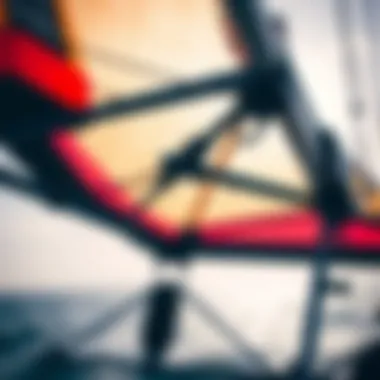
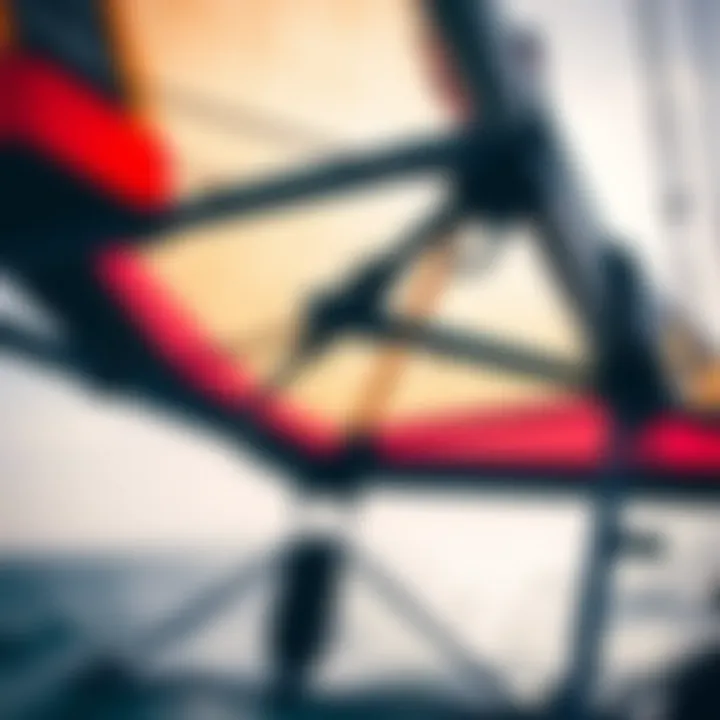
Intro
Kiteboarding has captured the hearts of many adventure lovers, intertwining the excitement of wind with the freedom of gliding over water. However, behind every thrilling ride lies a complex tapestry of components working together to ensure safety and performance. Understanding these parts isn’t just for the passionate kiteboarder; it's a vital piece of knowledge for anyone eager to embrace this exhilarating water sport. As we unravel the intricacies of kite parts, we’ll delve into the essential gear that beginners need and the advanced equipment experienced riders seek. This exploration will illuminate the important roles that each component plays, setting the stage for safer, more enjoyable kiteboarding sessions.
Gear and Equipment
When it comes to kiteboarding, having the right gear can make all the difference. With the wind at your back and a vast expanse of water before you, knowing what’s essential can elevate the whole experience.
Essential Kiteboarding Gear for Beginners
For those just getting their feet wet in the world of kiteboarding, a solid foundational gear setup is crucial. Here’s what you’ll need:
- Kite: The heart of kiteboarding, larger kites catch more wind but can be harder to control for beginners. A medium-sized kite often serves as a good entry point.
- Control Bar: This important piece allows you to steer the kite, controlling its position in the wind. It often comes with an integrated safety system.
- Harness: This item connects the rider to the kite, relieving pressure from your arms, ensuring you can harness the wind with your whole body.
- Board: Selecting the right board can depend on the conditions and your style. Beginners might start with a wider board for stability.
- Safety Gear: A helmet and impact vest are essentials to protect you from falls and unexpected crashes with your board or the kite itself.
Choosing the right gear can seem daunting. It’s wise to consult with more experienced riders or instructors for recommendations tailored to your local conditions.
Advanced Equipment for Experienced Riders
As skills improve, kiteboarders often look to upgrade their gear to enhance performance. Here’s a peek at what seasoned riders might invest in:
- High-Performance Kite: Advanced kites allow for refined handling and better performance in various wind conditions. These kites typically have more complex designs and materials, allowing for responsive flying.
- Carbon Fiber Boards: Lightweight and stronger, carbon boards can provide better performance and durability in challenging conditions.
- Hydrofoil: This equipment allows for a unique experience as it lifts the board above the water, reducing drag and offering a sensation akin to flying.
- Advanced Control Bars: These bars offer enhanced features like adjustable length or depower systems, giving experienced riders finer control over their kites.
Techniques and Tips
Alongside gear, mastering kiteboarding techniques is essential for maximizing enjoyment and safety.
Safety Practices for Kiteboarding
When kiteboarding, safety should always come first. Here are some practices to keep in mind:
- Always check the weather conditions before heading out. High winds or sudden storms can turn a fun day into a dangerous situation.
- Understand your kite's power zones and avoid oversteering, which can lead to crashes or losing control.
- Practice self-rescue techniques. In case of equipment failure, knowing how to self-rescue can be lifesaving.
"Understanding safety protocols not just helps in avoiding accidents; it empowers you to ride with confidence."
Training Techniques to Improve Your Skills
To truly become proficient, consider these effective training methods:
- Practice regularly: Consistent time on the water will boost your comfort and control.
- Join a local kiteboarding school: Instructors can provide invaluable insights into proper technique, safety measures, and gear choices.
- Watch the pros: Studying experienced riders can be enlightening. Many online forums and platforms, such as Reddit or social media groups, share their skills and experiences.
Kiteboarding is as much about community as it is about the thrill of the wind and water. Engage with others, share experiences and learn from each other. For additional resources and insights, visit sites like Wikipedia or Britannica. You may also want to check out different forums on Reddit for rider experiences and tips.
As you embark on or continue your kiteboarding journey, remember that understanding your equipment and techniques not only enhances performance but also promotes a safer experience on the water.
Intro to Kite Parts
Understanding kites and their various components is crucial for anyone looking to delve deeper into the world of kiteboarding. Kites are not merely colorful fabric caught in the wind; they are finely-sculpted machines that rely on a harmonious interplay of parts to achieve performance, safety, and fun. This section sets the stage for navigating through the intricate designs and functions of kite elements.
The Purpose of a Kite
Kites serve a multitude of purposes, from recreational play to professional sports. At their core, kites are designed to utilize wind energy effectively. They transform wind into lift, enabling riders to soar high above the water or land. Understanding the purpose behind each kite distinctively tailors its design, be it for catching air, performing tricks, or simply gliding gracefully across the blue expanse. The purpose of a kite goes beyond its aesthetic allure; it embodies a functional structure that demands expertise to optimize performance.
Imagine standing on a surfboard, feeling the wind tugging at the fabric, and launching into the sky. You'll quickly discover that kites work best when they are balanced; a well-structured kite ensures that the faster currents lift with ease, offering control and enhancing your overall experience. Thus, knowing the purpose is about comprehension and mastery — skills that separate experienced kiteboarders from novices.
Importance of Understanding Kite Components
To truly grasp the art of kiteboarding, one must possess a solid understanding of the kite's components. Each piece, from the frame to the lines, plays a pivotal role in the kite's functionality and performance.
Here’s why knowledge of kite components is paramount:
- Safety: Familiarity with the kite's anatomy allows kiteboarders to identify potential issues, reducing the risk of accidents. Knowing how to troubleshoot your gear can mean the difference between a smooth day on the water and a harrowing experience.
- Performance: Understanding each part helps you fine-tune your kite for various conditions. The right settings will help you harness the wind's power, perfect for those who chase adrenaline-fueled thrills.
- Customization: Different types of riding styles or weather conditions call for specific adjustments. The more you know about your kite, the better you can adapt it to your needs.
- Maintenance: Recognizing what each part does aids in proper upkeep, ensuring longevity of the gear. Ignoring maintenance can lead to costly repairs or early replacements.
In essence, grasping kite components is not only beneficial but essential for enhancing the kiteboarding experience. Through diving deep into each part, you can elevate your skills, ensuring your time spent on the board is as safe and enjoyable as it is exhilarating.
The Frame: Structure and Support
The frame of a kite is one of the most critical elements in its design, functioning as the skeletal structure that supports all other components. Essentially, it bears the burden of wind pressure, ensuring that the kite retains its shape in various conditions. A well-engineered frame not only enhances the stability of the kite but also significantly contributes to its flying efficiency. It serves as the backbone, delivering both resilience and flexibility, making it crucial for lighter winds and heavy gusts alike. Ultimately, a thorough understanding of kite frames is vital for improving performance and ensuring safety during kiteboarding activities.
Materials Used in Kite Frames
Different materials are employed when constructing kite frames, and these choices impact the performance, cost, and overall durability of the kite. Common materials include fiberglass, aluminum, and carbon fiber.
- Fiberglass: This material is widely used due to its cost-effectiveness and decent flexibility. It provides a good balance between strength and weight. While fiberglass is resilient, it may not withstand extreme conditions as well as stronger materials.
- Aluminum: Known for its lightweight properties, aluminum frames offer excellent rigidity. They are often found in entry-level to mid-range kites. Though durable, aluminum can corrode under certain conditions, especially when exposed to saltwater without proper care.
- Carbon Fiber: For those looking for top-tier performance, carbon fiber frames are the gold standard. These frames are incredibly lightweight and strong, ideal for high-performance kites. However, they come at a higher price and require careful handling to avoid damage.
Design Variations in Frames
Kite frame designs can vary significantly, affecting everything from performance to handling. The choice of frame design usually hinges on the intended use of the kite.
Single vs. Dual-Skin Designs
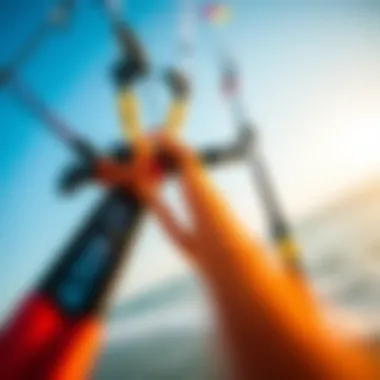
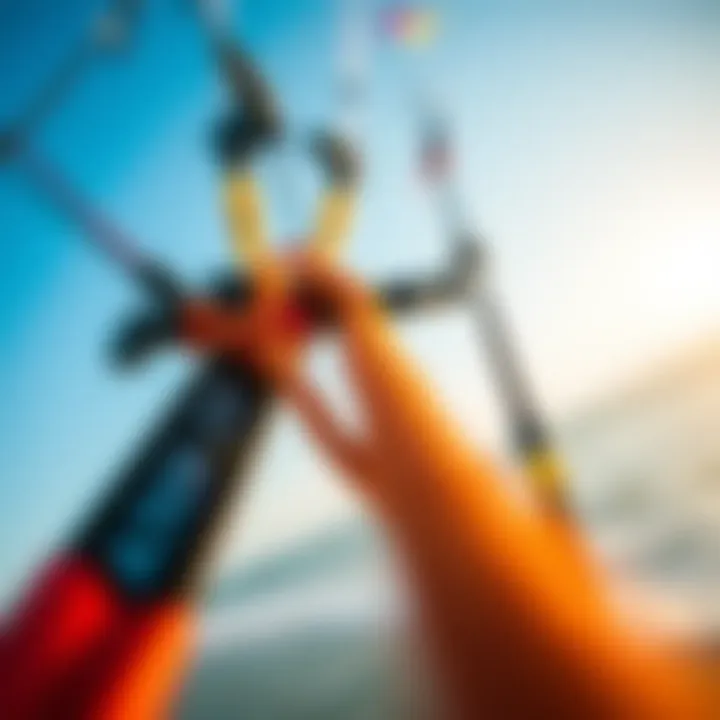
One aspect of kite frame design is whether to opt for single or dual-skin frames.
- Single-Skin Designs: This type features one layer of sail material stretched over the frame. Single-skin kites tend to be lighter and have increased maneuverability, making them popular among freestyle kiteboarders. However, they may lack some stability in turbulent conditions, requiring skillful handling.
- Dual-Skin Designs: These kites are built with two layers of sail material. This configuration tends to provide better stability and wind resistance. Dual-skin kites have a more robust structure, making them suitable for beginners who may not yet have mastered fine control. The downside to dual-skin designs is their increased weight, which may hamper agility.
Shape and Size Impacts
The shape and size of a kite's frame also influence its flight characteristics.
- Shape: Kites come in various shapes, including delta, bow, and c-shape designs. Each shape serves specific purposes, such as speed or lift. For instance, delta kites are known for their stability, while bow kites excel in lift and slow flying conditions.
- Size: The size of the kite defines much about how it performs. Larger kites catch more wind, making them ideal for light wind conditions but might be harder to manage in stronger winds. Smaller kites, conversely, are easier to control but may not perform well due to reduced lift in calm conditions.
Choosing the right shape and size could make or break a kiteboarder's experience. So understanding these aspects is essential for riders looking to fine-tune their kites for specific conditions.
The Sail: The Heart of the Kite
The sail acts as the kite’s primary lifting surface, playing a pivotal role in how a kite performs both in the air and in the water. When kiteboarding, the interaction between the sail and the wind determines much of the rider's experience, significantly impacting speed, maneuverability, and stability. Understanding the characteristics and types of sails not only provides insight into kite design but also informs riders about how to optimize their kites according to their skill level and riding style.
Sail Materials and Their Properties
Dacron vs. Ripstop Nylon
When choosing materials for the kite sail, Dacron and ripstop nylon come to the fore. Dacron is often chosen for its durability and resistance to UV exposure, making it a go-to for recreational kites. Its low stretch property ensures stable performance, especially during those long sessions at the beach. However, it's not the lightest material available which may sometimes hinder performance in low wind conditions.
Ripstop nylon stands out due to its lightweight and tear-resistant features. This fabric is engineered with a reinforcing technique that prevents rips from propagating, a critical advantage especially for adventurous riders who might encounter rough conditions. The trade-off, however, is that ripstop nylon might not be as resilient to UV damage, thus care must be taken during sessions under burning sun.
In summary, selecting between Dacron and ripstop nylon involves weighing the benefit of durability against the advantage of weight and performance.
Coatings and Treatments
Various coatings and treatments applied to sails can significantly impact their performance and lifespan. The common treatments include water resistance, UV treatment, and additional coatings that enhance durability. For instance, a water-resistant treatment can help in repelling moisture, which is particularly beneficial in maintaining the sail's integrity over time.
Another key feature is tape seams that seal the fabric and add structural strength, preventing water and wind penetration. This feature enhances the overall performance of the kite, especially during those unexpected weather changes. While these coatings offer numerous benefits, they can also increase cost and often may add a slight amount of weight to the sail.
Making informed choices about these coatings ensures that kite and rider can withstand various challenges faced in the dynamic nature of kiteboarding.
Sail Shape and Its Influence on Performance
The shape of the sail is far from a mere aesthetic feature; it forms the backbone of the kite's aerodynamic efficiency. A flatter profile can result in faster speeds, making it preferable for high-performance riding. On the other hand, a more curved shape generally results in increased lift, which can be advantageous for those who enjoy slower and more controlled flights or tricks.
Kites with specialized shapes, like delta or bow kites, are designed for specific purposes and rider styles. For instance, delta kites are known for their ability to handle high winds, providing the rider with stability required in challenging conditions.
It's crucial for kiteboarders to understand that the sail's shape not only affects performance but also the overall feel of the kite. A keen awareness of this can lead to better decision-making when selecting kites or tuning them to enhance performance based on wind conditions or personal preference.
"The sail’s design, materials, and shape are all intricately linked to the performance and enjoyment of kiteboarding. Understanding these can dramatically transform how one interacts with the kite."
By appreciating the critical role the sail plays, kiteboarders can better tailor their equipment to not only meet their performance needs but also enhance their overall experience on the water. Exploring these fundamental aspects opens up a realm of possibilities for improving skills and enjoying the thrill of kiteboarding.
Lines: The Connection to the Rider
In kiteboarding, the lines act as the vital connection between the rider and the kite itself. These lines are not just mere strings; they transmit forces and enable control, enhancing the rider's experience significantly. Understanding the characteristics and functions of the lines is essential for mastering the art of kiteboarding. When equipped with the right lines, riders can optimize their performance and safety on the water.
Types of Lines: Monofilament vs. Braided
When it comes to kite lines, there are primarily two types: monofilament and braided. Monofilament lines are typically made from a single strand of material, often resulting in a smoother surface. This smoothness can lead to decreased drag, which might be particularly beneficial in lighter winds. Moreover, monofilament lines tend to stretch less compared to braided lines, giving riders a more direct feel when controlling their kite. However, this type isn't necessarily the strongest, and over time, it might wear out more quickly under high tension.
On the other hand, braided lines consist of multiple strands woven together, creating a stronger, more durable structure. They offer excellent strength-to-weight ratios, making them a popular choice among more aggressive kiteboarders. Braided lines can handle harsher conditions but may introduce more drag due to their textured surface. Each type has its pros and cons, and the choice between monofilament and braided lines largely depends on the rider's preferences and the conditions they expect to encounter.
Line Length and Its Effects
The length of the lines can dramatically influence kite performance, control, and overall riding experience.
Short vs. Long Lines
Short lines, generally around 20 to 25 meters, can provide quick responsiveness and allow the kite to change direction faster. This can be particularly advantageous for riders who enjoy tricks or rapid maneuvers. The closeness of the kite to the rider offers a sense of connection that many find exhilarating. However, one drawback is that short lines can create a steeper angle of attack, making it more challenging to maintain power in lower wind conditions.
In contrast, long lines, often ranging from 25 to 35 meters, offer a more steady pull and a smoother flight. Riders can also benefit from improved lift and the ability to harness more wind energy. Nevertheless, long lines may lead to decreased responsiveness, which could impact trick performance. The decision between short and long lines often comes down to the rider's style and the specific conditions they face on the water.
Adjustability and Control
Adjustability in the length of lines is another crucial aspect. Kite systems that allow adjustments enable riders to fine-tune their setup based on prevailing wind conditions and personal preference. More adjustability means riders can shift between shorter or longer lines as needed, which can drastically change how the kite behaves in the air.
One of the key characteristics of adjustable lines is their versatility; they permit users to switch between trick-heavy and speed-focused riding styles seamlessly. While this may seem convenient, it's important to note that frequent adjustments might stress the line material, potentially compromising its integrity over time. A responsibility falls on the rider to regularly inspect and maintain the lines for safety during use.
"Lines are not just features of your kite; they are the lifeline of your kiteboarding prowess. Choose wisely, maintain diligently, and control effortlessly."
From adjusting line lengths to selecting the right type, considerable thought goes into optimizing your equipment for the best experience. The dynamics of the kiteboarding journey are intricately linked to the lines, proving that they truly are the connection from rider to kite.
Kite Control Bar: The Interface with the Kite
The control bar serves as the lifeline between the rider and their kite, allowing for precise adjustments and steering during flight. It's not just a mere accessory; its construction and features are central to a kiteboarder's experience on the water. A well-designed control bar can enhance navigation, increase response times, and ultimately affect the safety and performance of a kiteboarding session.
Crucially, when selecting a control bar, one must take into account the various components that contribute to its functionality. This section discusses the inner workings of the control bar, focusing on its essential elements, their benefits, and what one should consider when making a decision.
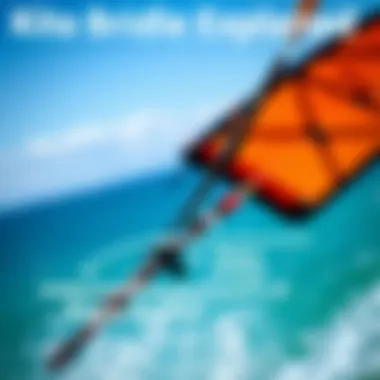
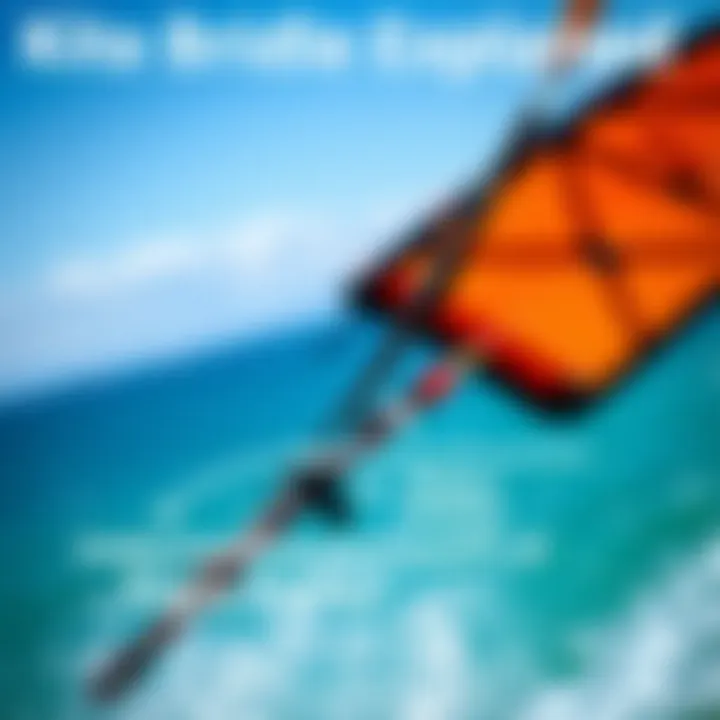
Components of the Control Bar
Bar Width and Grip
The width of the control bar is an aspect that should not be taken lightly. Wider bars allow for more leverage, which means you can exert greater control over the kite, especially in challenging wind conditions. This is particularly true for experienced riders who may require quick, aggressive movements to maintain balance and direction. On the other hand, narrower bars tend to be favored by beginners, as they offer a more manageable grip and are ideal for learning the ropes.
The grip material is another defining feature. A soft, textured grip can provide a comfortable feel, preventing slipping during steeper maneuvers. A popular choice is EVA foam, which offers a warm touch and excellent hold. The downside? While it’s comfortable, it might wear out faster than other materials. A good grip not only aids in control but also contributes to reduced fatigue during extended sessions.
Adjustable Features
One of the key attributes of modern control bars is their adjustable features. Many bars come equipped with options that allow riders to customize their experience. Adjustability can involve changing the width of the bar, which alters how much force is needed to turn the kite. This feature can be crucial for riders who progress from beginner to advanced levels, allowing for a tailored experience as skill improves.
Additionally, adjustable depower straps enable riders to easily modify how much power the kite generates. This is especially advantageous for managing unexpected shifts in wind conditions, granting riders the ability to smooth out rough patches or harness enhanced power when needed. However, while these features add flexibility, they also complicate the setup process, which could be daunting for novice kiteboarders.
Safety Systems Integrated into Control Bars
Safety can't be overstated when it comes to kiteboarding, and it hinges significantly on the control bar's design. Many contemporary control bars include integrated safety systems, such as quick-release mechanisms that allow a rider to disengage from the kite swiftly. In emergencies, this can prove to be a lifesaving feature.
These safety systems often utilize a single-line release, making it simple for a rider to activate while maintaining a steady grip on the bar. While this feature adds layers of security and peace of mind, it’s essential that all riders fully understand how to use these safety mechanisms before heading out.
In summary, understanding the role of the control bar is pivotal in kiteboarding. Its various components and features can dramatically influence not only the efficacy of kite management but also rider safety. To strap in and take off into the wind, mastery of the kite control bar is imperative for every kiteboarder.
Leashes: Essential Safety Components
Leashes play an important role in kiteboarding. They act like a lifeline, keeping the rider connected to the kite while allowing for freedom of movement. Understanding the different types of leashes and how to use them effectively is critical for safety and performance. In this section, we will unpack the different leashes utilized in kiteboarding and how proper connection techniques can enhance safety and usability.
Different Types of Leashes
When it comes to leashes, not all are created equal. Each type caters to distinct needs and preferences in the kiteboarding community. Here are the most commonly used ones:
- Standard Leash: This leash attaches the rider to the kite and typically features a single line connection. This style is popular for its simplicity and effectiveness but might offer less flexibility in certain situations.
- Safety Leash: A safety leash is crucial for emergencies. Often designed to quickly release the kite from the rider, it ensures that if something goes wrong, the rider is not pulled underwater or away from the area. Many safety leashes incorporate a quick-release mechanism or a bungee to absorb shocks and protect the rider during sudden movements.
- Wrist Leash: A wrist leash is more common in disciplines like kitesurfing and is great for riders who prefer to stay close to their board. This type helps keep the board from getting lost in the water, though it might not provide the same safety features as a standard leash.
- Dual Leash System: Some advanced setups utilize two leashes for added security and adjustments. This typically includes one leash for safety and another for direct control. While more complex, this option offers enhanced versatility and allows for quicker responses in tricky situations.
Leash Connection and Usage
The way you connect and use your leash can make a significant difference in your overall kiteboarding experience. Proper connection ensures you stay linked to your kite without losing control or risking entanglement.
When connecting your leash, it’s vital to ensure that you’re using the right attachment point on the harness. Most harnesses have designated loops or points to attach your leash. Here’s a simple guide on how to connect your leash:
- Choose the Right Loop: Depending on the design of your harness, select the appropriate loop or connection point. Generally, this will be found on the back of the harness to avoid impacting your movement.
- Secure the Connection: Make sure that the connection is tight and secure. A loose leash can result in swift disconnections during jumps or turns. Always double-check the clasp or hook.
- Adjust Length: If your leash is adjustable, set it to a comfortable length. You don’t want it to be too long, as this can lead to getting caught in the lines or the kite itself.
- Practice Quick Release: Familiarize yourself with your leash's quick-release system. In case of emergencies, being comfortable with this feature can make all the difference.
"The leash is not just a tool; it's your safety net in the vast, dynamic environment of kiteboarding. Understanding its components and usage is key."
By following these steps and utilizing the right type of leash, kiteboarders can enjoy a much safer and more enjoyable ride. Whether you're a novice or seasoned pro, the leash is a vital component that should never be overlooked.
Kite Inflation System: Preparing for Flight
When it comes to kiteboarding, the kite inflation system is a crucial player in ensuring the successful launch and overall performance of your kite. A well-inflated kite not only enhances lift but also stabilizes the entire setup in the air. Without proper inflation, you're likely to find yourself in a heap of trouble, battling lackluster performance or even accidents on the water.
Understanding the inflation system is not just about inflating your kite; it’s about setting the stage for a smooth ride. The kite needs to be fully inflated before you hit the waves. This allows the shape to be maintained, the sail to catch the wind effectively, and reduces the risk of excessive fluttering or even collapse during flight. So, let’s delve deeper into the types of inflation systems and effective techniques to ensure your kite stands tall and proud in the sky.
Types of Inflation Systems
Kites typically come equipped with a few different inflation systems. Knowing which one your kite has can make a world of difference in terms of ease and effectiveness. The notable types include:
- Single-Point Inflation Systems: This type requires one inflation point and generally leads to quicker setups. However, it may not always deliver even inflation throughout the kite, especially in larger designs.
- Multi-Point Inflation Systems: More sophisticated kites often employ this system, allowing for multiple points to inflate the kite. This ensures the entirety of the structure fills out properly, enabling optimal performance.
- One-Pump Systems: This system simplifies the process; inflating the entire kite occurs through a single hose. It’s efficient and widely preferred for its speed, provided the system functions effectively.
- Strut Inflation: More common in advanced kites, strut inflation ensures that each specific area of the kite maintains its shape as it inflates, enhancing overall stability and maneuverability.
Each of these systems has its own merits and drawbacks. One must consider aspects like setup time, the size of the kite, and even personal preferences when choosing an inflation system.
Inflation Techniques for Stability
Getting the right inflation is just one part of the puzzle. The technique employed during the inflation process significantly impacts the kite’s performance in the air. Certain practices can lead to a stable, gracefully flying kite rather than a clumsy, struggling one. Here are a few effective inflation techniques for ensuring stability:
- Inflate in Controlled Conditions: Don’t inflate your kite in high winds or turbulent conditions. Find a calm spot on the beach, ensuring the kite is positioned correctly before inflation.
- Check for Consistency: As you inflate, keep an eye out for any irregularities. If one area isn’t filling, adjust the inflation accordingly. You'd be surprised how a little attention here can prevent noticeable performance issues later on.
- Avoid Over-Inflation: It’s a common misconception that more is better. Over-inflating can lead to stark rigidity, resulting in unpredictable behavior in the air. You want a taut kite, not one that resembles a stretched balloon.
- Pressurize in Steps: Especially with larger kites, consider inflating gradually. Inflate a little, check the kite’s profile, then continue—this may take longer, but it ensures every inch of the kite is performing as it should.
Proper inflation prepares your kite not only for takeoff but for sustained performance throughout your ride. Always remember, the effort put into getting this part right can make the difference between a good session and a frustrating one.
"Details are not just details; they make the design."
Understanding these components will help kiteboarders of all skill levels find that sweet spot in performance. Regularly practicing these techniques can lead not only to better rides but to greater enjoyment on the water. Embrace the process, and you will see the rewards in the air.
Bridles: The Link Between Sail and Control
Bridles are oftentimes overlooked but they play a pivotal role in the functionality of kites, particularly in kiteboarding. Think of bridles as the unsung heroes that connect the kite’s sail to the control system. They help in balancing the forces exerted on the kite while it's airborne. Essentially, they provide stability and help the rider maintain control. This section takes a closer look into their significance, roles, and various configurations.
Understanding the Role of Bridles
Bridles serve as a crucial link between the sail and the control bar, adjusting the angle and tension of the sail for optimal flight. Without a proper bridle setup, the kite may not perform well, leading to undesirable flight patterns and challenges in maneuverability. When the bridle is correctly calibrated, it ensures that the kite responds promptly to the rider’s commands, thereby enhancing the overall experience.
Consider a kite with an incorrectly set bridle. It might pull to one side, creating an inconsistent performance that complicates the rider's control. This misalignment could easily result in a frustrating session, limiting skill development and inhibiting the rider's ability to grasp basic techniques.
Bridles also regulate the aspect of lift and drag. Think about how a bird adjusts its wings in flight. Likewise, a kite’s bridle configuration can adjust how effectively it harnesses wind, optimizing performance and maneuverability. For the kiteboarder seeking to elevate their skills, grasping the nuances of bridles is not merely beneficial but essential.


Bridle Configurations and Their Impact
The arrangement of bridles can vary significantly from one kite model to another. Different bridle configurations can affect the kite's aerodynamic properties, responsiveness, and overall stability. Here are some common bridle setups:
- Single Point Bridles: These connect the sail at one point, allowing it to pivot easily on that point, which can enhance maneuverability but may compromise stability.
- Multi Point Bridles: These involve several connections that help distribute the load across the sail, lending to increased stability.
- Adjustable Bridles: Some kites offer adjustable bridles, allowing for fine-tuning based on conditions or rider preference.
Each configuration has its pros and cons. For instance, a single point bridle may allow for a more dynamic flight but lacks the balanced support that a multi-point bridle can provide. In windy conditions, a multi-point bridle can help keep the kite stable, making it an ideal choice for novice riders still getting their bearings.
Similarly, how the bridle is attached to the control lines can have a substantial impact. A higher attachment point can enhance lift, whereas a lower point might better control movement, allowing riders to tailor their experience based on the day’s conditions or their specific style. Understanding these configurations can turn an average day on the water into a thrilling flight session.
"The right bridle configuration can mean the difference between a smooth glide and a rough ride."
Whether you are a seasoned kiteboarder or a budding enthusiast, taking the time to explore bridles and their configurations is well worthwhile. They are the foundational link that binds the sail and control systems, and mastering this component can greatly enhance your performance in the air. Learning how to adjust and tune bridles is not just recommended but essential for anyone keen on making the most out of their kiteboarding experience.
Tuning Your Kite: Adjustments for Performance
Tuning your kite involves making careful adjustments that enhance its overall performance, safety, and responsiveness. For kiteboarders, whether newbies or veterans, understanding the nuances of tuning can mean the difference between a frustrating session and a superb ride. It ensures that your kite operates efficiently under various wind conditions and meets your personal riding style.
Why Tuning is Necessary
Tuning is an integral component of kiteboarding that is often overlooked. Think of your kite as a finely tuned instrument; it won’t perform optimally if it’s out of sync. Proper tuning can enhance lift, improve maneuverability, and provide stability. When the kite is well-tuned, riders can execute jumps and tricks with greater ease. In contrast, a poorly tuned kite may feel sluggish and may even become dangerous in adverse conditions.
Moreover, winds are not uniform; they shift and change. A kite that is tuned for specific wind conditions will perform significantly better than one that is left in its factory settings. Tuning allows for adaptability, ensuring that riders have a tailor-made experience that meets their individual needs.
Common Tuning Adjustments
In kiteboarding, two primary aspects often require tuning: line lengths and bridle settings. Each adjustment plays a pivotal role in how the kite behaves in the air, and mastering them can unlock a whole new level of performance.
Line Length Adjustments
Adjusting line length is an essential aspect of tuning. It influences how the kite interacts with the wind and how responsive it feels. Longer lines typically increase power and extend the kite's flight range, allowing for a more extended reach and better lift.
- Key Characteristic: The primary attraction of longer lines is the added power. When you gain altitude, you can catch stronger winds.
- Benefit: Longer lines are highly favorable for big-air sessions or when sailing in gusty conditions, as they can help manage unexpected shifts in wind.
- Unique Feature: However, longer lines do come with tactical trade-offs; controlling the kite can become less intuitive under certain circumstances. Riders might find themselves in a situation where the kite responds slowly to commands, especially during tighter maneuvers, so it is essential to find a sweet spot that feels right.
Bridle Adjustments
Bridle adjustments offer another critical avenue for tuning. The bridle system is what connects the sail to the control lines, and changing its length or configuration can dramatically alter the kite's performance.
- Key Characteristic: By adjusting the bridle, riders can fine-tune lift and stability. A higher attachment point can make the kite fly higher in the window, whereas a lower adjustment can improve stability and control.
- Benefit: Bridles are particularly beneficial in adapting kites to various wind conditions; tweaking them allows the rider to harness more lift or stabilize the flight path depending on the scenario.
- Unique Feature: The complexity of bridle adjustments can be a double-edged sword. While they provide versatility, they also require a bit of experimentation. A subtle tweak one day might not yield the same results the next, depending on the changing winds.
"Tuning is not just about performance. It's about understanding your kite and what it needs on any given day."
When it comes to kite tuning, patience and practice go a long way. Each adjustment allows riders to have greater control over their kite, leading to more enjoyable sessions on the water. Whether it’s fine-tuning line lengths or bridle configurations, each small tweak can contribute significantly to the overall experience.
For further reading on kiteboarding, you can check resources at Wikipedia, Britannica, and community forums like Reddit.
In the world of kiteboarding, knowledge and precise adjustments are key to becoming a competent rider.
Maintenance and Care of Kite Parts
Maintaining and caring for kite parts is essential for ensuring their longevity and optimal performance. Just like you wouldn’t drive a car without regular oil changes and tire checks, neglecting your kite can lead to a not-so-pleasant experience when you hit the water. With the right maintenance techniques, kiteboarding enthusiasts can look forward to countless days of fun under the sun.
Cleaning Techniques for Kite Components
Keeping your kite components clean not only enhances their appearance but also prolongs their functional life. Saltwater, sand, and debris can accumulate on a kite, leading to wear and tear over time. Here's how to keep your kite in tip-top shape:
- Rinsing Off After Use: After every session, give your kite a thorough rinse with fresh water. This helps to remove salt and sand that can degrade the materials.
- Gentle Soap Solution: If you notice stubborn stains or spots, a mild soap diluted in water can work wonders. Just make sure to rinse it well to avoid any residue left behind.
- Drying Techniques: Avoid folding your wet kite. Instead, spread it out flat or hang it for air drying in a shady spot. Direct sunlight can degrade some materials, so it’s best to keep it covered.
- Cleaning Lines and Bars: The lines can be cleaned similarly with a rinse and a soak in soapy water. Gently rub off any salt or grit, then rinse thoroughly. For control bars, wipe them down with a damp cloth to eliminate dirt buildup.
"A well-maintained kite can mean the difference between a smooth ride and an unexpected mishap on the water."
Storage Recommendations
How you store your kite is just as crucial as how you clean it. Proper storage will protect your kite from damage and help maintain its performance. Here are some tips for smart storage:
- Keep It Dry: Always store your kite in a dry environment. Moisture can promote mold and mildew growth, which can ruin the materials.
- Use a Bag: Most kites come with storage bags. If you have one, use it! It provides an extra layer of protection against dust and dirt.
- Avoid High Heat: Storing your kite in areas subject to extreme temperatures is a big no-no. Heat can warp or damage the materials, especially plastics and fabrics.
- Flat or Loosely Rolled: Store your kite flat or loosely rolled. Tight rolls can create creases that weaken the structure over time.
- Keep Away from Sharp Objects: Ensure that your storage area is clear of items that could potentially puncture or damage the kite.
By implementing these care and maintenance techniques, kiteboarders can enjoy their gear longer and face fewer issues out on the water. A little attention goes a long way in preserving the quality and safety of kite components, enhancing the overall kiteboarding experience.
Ending: Mastering Kite Parts for Enhanced Performance
In the realm of kiteboarding, understanding each component of your kite can significantly affect your overall experience. This article has dissected the anatomy of kites and laid out the foundations that contribute to performance and safety. By grasping the intricacies of kite parts—from the frame to the lines—you not only enhance your knowledge but also your skills on the water. Mastering these elements translates into better control, higher efficiency, and a deeper appreciation of the sport.
The interaction between the kite frame and the sail, for example, is pivotal. A sturdy frame complements a well-designed sail, ensuring that your kite can withstand the rigors of the wind and turbulent conditions. Additionally, understanding the lines and control bar allows a kiteboarder to make informed decisions about adjustments during flight. Ultimately, these insights can be the difference between a mild breeze and a wind-fueled adrenaline rush.
Summarizing Key Points
- Kite Integrity: The kite frame, sail, and lines collectively govern performance. Ensuring quality and compatibility among them is paramount.
- Control Mechanisms: A well-functioning control bar and lines provide vital feedback. Adjustments can elevate your performance levels during kiteboarding.
- Safety First: Understanding all components means being aware of safety systems, making each ride not just fun but secure as well.
Each piece of your kite has a unique role, and mastering these parts means you’re better equipped to handle various conditions and challenges. This foundational understanding leads to safer and more enjoyable kiteboarding.
The Importance of Continuous Learning
Kiteboarding, much like any sport, involves an ever-evolving landscape of technology, techniques, and environmental conditions. Continuous learning is essential for anyone looking to excel. With new materials and designs emerging frequently, staying updated can give you the edge.
Consider joining forums on platforms such as Reddit or engaging with communities on social media. Websites like Wikipedia provide useful historical context and updates about modern advancements.
Furthermore, attending workshops or kiteboarding expos can be invaluable for hands-on experience. These opportunities not only enrich your understanding but also connect you with like-minded individuals passionate about the sport.



